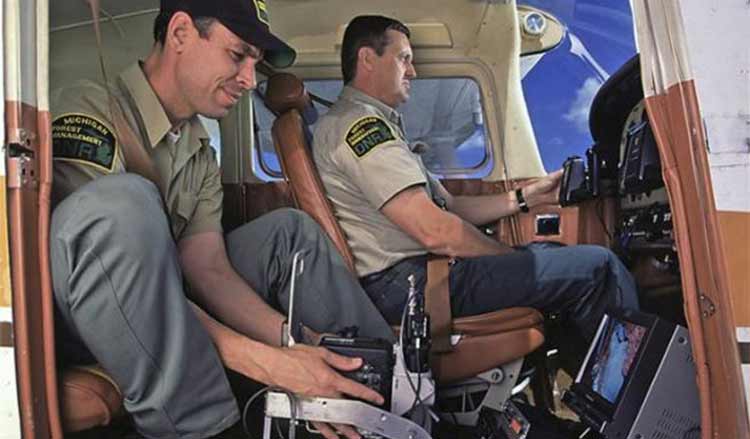
Michigan DNR pilot Bill Green and biologist Roger Mech prepare for a forest monitoring flight. David Kenyon/Michigan DNR
No realm of piloting provides more career opportunities than government, or public service, flying. The Armed Forces, federal agencies, state aeronautics divisions and aviation departments, and county and municipal authorities employ pilots to operate what is by all accounts the world’s largest fleet of fixed- and rotor-wing aircraft and remotely piloted aerial vehicles.
The numbers of these jobs and pilots are unknown. The FAA maintains no count on pilots who fly for federal agencies (some agencies, such as Customs and Border Protection, shield such data), and no tabulation of aviators who fly for state governments exists, according to the National Association of State Aviation Officials, which represents the state aviation agencies of all 50 states plus Guam and Puerto Rico. At the municipal and county level, where operations often focus on airborne law enforcement, the most comprehensive data, now a decade old (2007 Census of Law Enforcement Aviation Units), found more than 900 law-enforcement aircraft were operated by some 1,700 pilots flying for about 200 agencies in 46 states and the District of Columbia.
Today, “there are probably more available jobs out there now than any time in recent history,” says Tory Meisel, flight operations manager for Wyoming Department of Transportation’s Aeronautics Division, whose eight pilots operate two Citation Encores and a Cessna Caravan. “It is difficult to find quality candidates, so anyone committed to the profession should not have difficulty finding work.”
While opportunity abounds, applicants “have to do their homework,” says Jeff Brown, of Caltrans Division of Aeronautics, because each agency, force and operating authority “is going to have their own particular requirements” for pilot positions. Caltrans, for example, is one of five agencies in California that operate aircraft, each with its own hiring criteria.
Military Pilots
The U.S. Air Force, Army, Navy, Marine Corps and Coast Guard employ pilots, though the services primarily train rather than hire them. Currently all face pilot shortages, with the Air Force recently stating it needs 2,000 additional pilots and Congress working to cement retention bonuses for military pilots.
A bachelor’s degree and an officer’s commission are among basic requirements for flight training, and enrollment in the service academies provides the most direct route. But ROTC, Officer Candidate School for enlisted personnel, and direct commission officer appointments for pilots transferring from current or former service in one branch to another are among alternative channels. Candidates for ROTC slots can gain an advantage by getting a few hours of flight training, says Annette Crawford, public-relations manager at the Order of Daedalians. This fraternal order of military aviators provides flight training and academic scholarships to aspiring military aviators with financial needs. “We found a lot of ROTC instructors at different colleges and universities want students to have flying time and to have soloed to compete for flying spots,” says Crawford, a former Air Force recruiter.
Federal Agencies
The National Park Service, Forest Service, Fish and Wildlife Service, Bureau of Land Management, National Oceanic and Atmospheric Administration, NASA and the FAA are among federal fleet operators that employ pilots. Piloting is usually complementary to an employee’s primary job, as seen in job titles like biologist/pilot among NPS pilots, or research pilot/aeronautical engineer at NASA. Some agencies, including Fish and Wildlife, provide primary flight training for qualified employees seeking to expand career opportunities.
Agencies that operate sophisticated aircraft, such as NOAA and NASA, obviously don’t provide initial pilot certification training. In addition to impeccable piloting skills and experience, NOAA, whose fleet includes de Havilland Twin Otters and WP-3D Orion Hurricane Hunters, requires applicants to have college-level calculus or physics studies as well as a bachelor’s degree.
Applicants with the requisite resumes not only get to fly rare and exciting aircraft, but also can be paid well to do it. A recent NASA posting for a research pilot/aeronautical engineer for “the development, design, testing, evaluation and reporting on new aircraft concepts and new advanced aircraft systems” listed the pay scale as GS-14, with an annual salary between about $105,000 and $137,000.
Airborne law enforcement (ALE) — a subject we’ll profile on its own — is provided at the federal level by agencies including CBP, the FBI and Department of Homeland Security, while even the NPS has ALE pilots among its Park Police personnel.
State and Municipal Governments
All states employ pilots and operate aircraft for a wide range of missions, in addition to transporting state employees and officials on business. They work under the aegis of state departments of transportation, aeronautics or aviation, and sometimes additional agencies. Natural-resources or fish-and-game departments may use aircraft for wildlife population surveys and poacher patrols. Public-safety agencies may conduct search-and-rescue and medevac missions. ALE units may serve double duty as airborne firefighters. Caltrans’ Division of Aeronautics is primarily responsible for airport and heliport safety. This division has seven aviation safety officer pilots and operates two Beechcraft Bonanzas, used on rounds to inspect airport signage and other items outside of the FAA’s safety purview.
“Pilots assume everything is going to be safe at an airport,” says Brown, a former Coast Guard aviator. “The work we do makes sure it is. That’s front and center for us and helps make the job worthwhile and interesting.” Caltrans applicants must have a fixed-wing commercial-pilot certificate with instrument rating, a bachelor’s degree and three to five years of airports operations, planning or safety officer experience. Safety officer salaries in California range from about $68,000 to $85,000 annually, while senior safety officer pay tops out at about $95,000.
Hiring at state levels for pilots is driven primarily by state budgets, which have been fairly static in recent years.
Contact information for state aviation authorities is available here.

Sign-up for newsletters & special offers!
Get the latest FLYING stories & special offers delivered directly to your inbox






